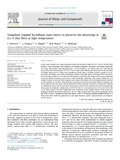Mostrar el registro sencillo del ítem
Vanadium trapped by oblique nano-sheets to preserve the anisotropy in Co-V thin films at high temperature
| dc.creator | Favieres Ruiz, Cristina | es_ES |
| dc.creator | Vergara Platero, José | es_ES |
| dc.creator | Magén, César | es_ES |
| dc.creator | Ibarra, Manuel Ricardo | es_ES |
| dc.creator | Madurga Pérez, Vicente | es_ES |
| dc.date.accessioned | 2022-05-27T08:33:49Z | |
| dc.date.available | 2022-05-27T08:33:49Z | |
| dc.date.issued | 2022 | |
| dc.identifier.citation | Favieres, C.; Vergara, J.; Magén, C.; Ibarra, M. R.; Madurga, V.. (2022). Vanadium trapped by oblique nano-sheets to preserve the anisotropy in Co-V thin films at high temperature. Journal of Alloys and Compounds: an interdisciplinary journal of materials science and solid-state chemistry and physics.. 911, 1-12 . | en |
| dc.identifier.issn | 0925-8388 | |
| dc.identifier.uri | https://hdl.handle.net/2454/43041 | |
| dc.description.abstract | In this study, oriented nano-sheets generated during the growth of cobalt-rich Co–V and Co–Zn thin films induced a large anisotropy in the magnetic and transport properties. The regular nano-sheets were tilted 52–54 deg. with respect to the substrate plane, ≈ 3.0–4.0 nm thick, ≈ 30–100 nm wide, and ≈ 200–300 nm long, with an inter-sheet distance of ≈ 0.9–1.2 nm. In spite of the different microstructures of the two kinds of samples where the Co–V films were amorphous, whereas the Co–Zn films showed a growth of Zn nanocrystals, the oblique nano-sheet morphology conferred noticeable shape anisotropy to both specimens. This anisotropy resulted in an in-plane uniaxial magnetic anisotropy. The changes in the nano-morphology caused by thermal treatments, and hence in their anisotropic properties, were studied. While the Co–V samples retained or increased their magnetic and transport anisotropies, this anisotropic behavior vanished for the annealed Co–Zn films. High resolution transmission electron microscopy, HRTEM, including chemical analysis at the nano-scale, and the dependence of the anisotropic resistance on temperature allowed to establish the nature and the activation energy spectra of the atomic relaxation processes during heating. These processes displayed a single peak at 1.63 eV for the Co–V and two peaks at 1.67 and 2.0 eV for the Co–Zn. These spectra and their singularities were associated to the changes induced in the nano-morphology of the films by thermal treatments. The Co–V films retained their nano-sheet morphology almost up to 500 ºC; the Co–Zn films lost their nano-sheets at 290 ºC. The thermal stability exhibited by the Co–V films makes them useful for applications in ultra high frequency, optical, magnetostrictive and magnetoelectric devices. | en |
| dc.description.sponsorship | C. F., J. V., and V. M. acknowledge the financial support of the Public University of Navarre. C.M. and M.R.I. acknowledge the financial support from the Spanish Ministerio de Economía y Competitividad in the project MAT2017–82970-C1 and C2-R and from the Aragón Regional project E26. Open access funding provided by Universidad Pública de Navarra. | en |
| dc.format.extent | 12 p. | |
| dc.format.mimetype | application/pdf | en |
| dc.language.iso | eng | en |
| dc.publisher | Elsevier | en |
| dc.relation.ispartof | Journal of Alloys and Compounds 911 (2022) 164950 | en |
| dc.rights | © 2022 The Author(s). Creative Commons Attribution-NonCommercial-NoDerivatives 4.0 International (CC BY-NC-ND 4.0) | en |
| dc.rights.uri | http://creativecommons.org/licenses/by-nc-nd/4.0/ | |
| dc.subject | Thin films | en |
| dc.subject | Nano-fabrications | en |
| dc.subject | Anisotropy | en |
| dc.subject | Electrical transport | en |
| dc.subject | Scanning tunnelling microscopy, STM | en |
| dc.subject | Transmission electron microscopy, TEM | en |
| dc.subject | Electron energy loss spectroscopy, EELS | en |
| dc.title | Vanadium trapped by oblique nano-sheets to preserve the anisotropy in Co-V thin films at high temperature | en |
| dc.type | info:eu-repo/semantics/article | en |
| dc.type | Artículo / Artikulua | es |
| dc.date.updated | 2022-05-27T08:33:48Z | |
| dc.contributor.department | Zientziak | eu |
| dc.contributor.department | Institute for Advanced Materials and Mathematics - INAMAT2 | en |
| dc.contributor.department | Ciencias | es_ES |
| dc.rights.accessRights | info:eu-repo/semantics/openAccess | en |
| dc.rights.accessRights | Acceso abierto / Sarbide irekia | es |
| dc.identifier.doi | 10.1016/j.jallcom.2022.164950 | |
| dc.relation.projectID | info:eu-repo/grantAgreement/AEI/Plan Estatal de Investigación Científica y Técnica y de Innovación 2013-2016/MAT2017-82182-R/ES/ | en |
| dc.relation.projectID | info:eu-repo/grantAgreement/AEI/Plan Estatal de Investigación Científica y Técnica y de Innovación 2013-2016/MAT2017-82182-R/ES/ | en |
| dc.relation.publisherversion | https://doi.org/10.1016/j.jallcom.2022.164950 | |
| dc.type.version | info:eu-repo/semantics/publishedVersion | en |
| dc.type.version | Versión publicada / Argitaratu den bertsioa | es |
| dc.contributor.funder | Universidad Pública de Navarra / Nafarroako Unibertsitate Publikoa | es |



